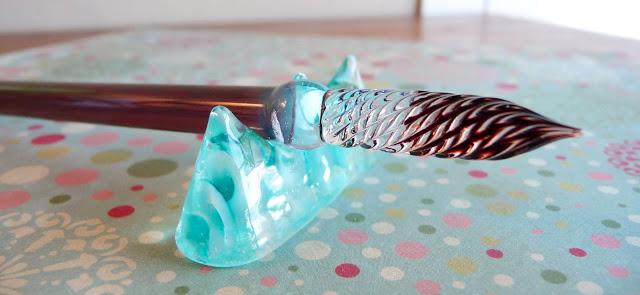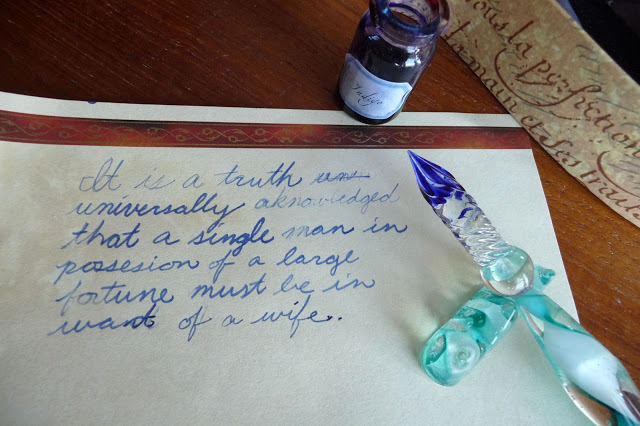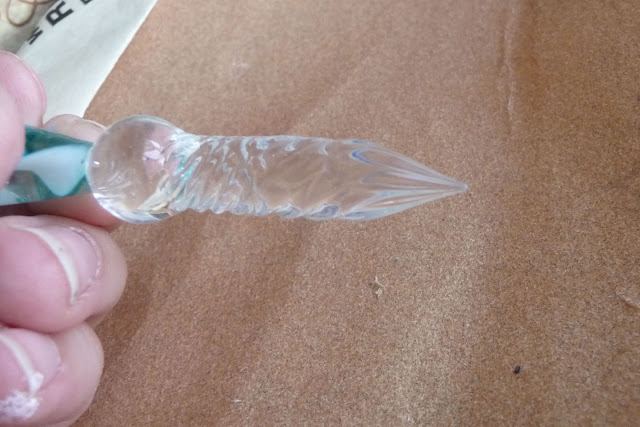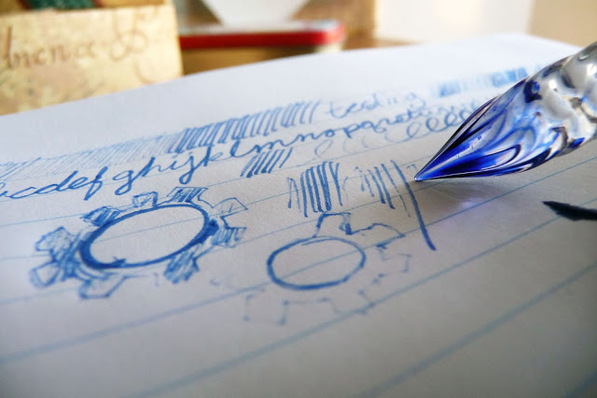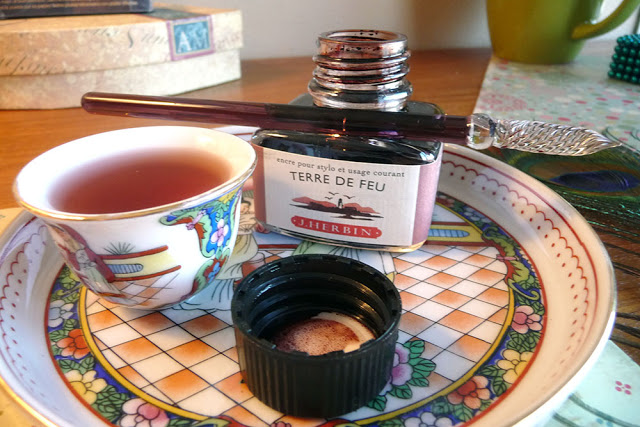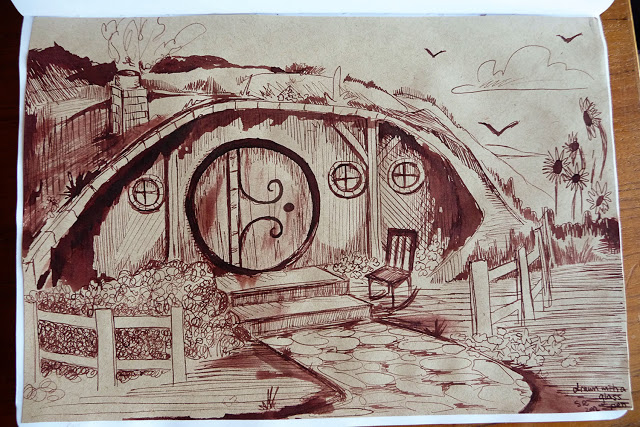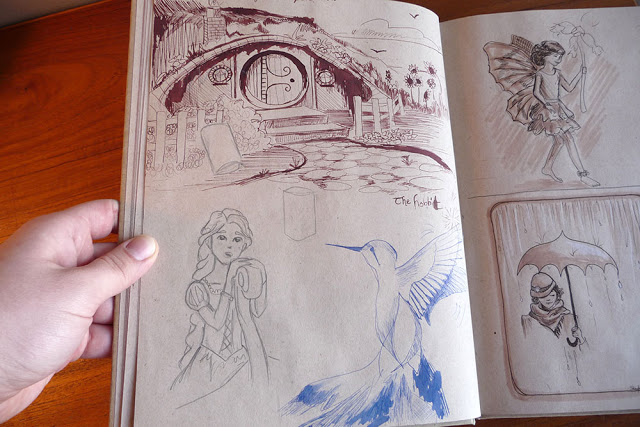|
The Breadcrumbs widget will appear here on the published site.
Venetian Glass PensI love words. I love lines. I love the stories you can weave into books and drawings with a thousand swishes of a pen. I love typography and calligraphy and making sure that words and pictures get mixed together into a beautiful mess of this thing called "art." I'm the sort of person who collects pens and art supplies and actually uses them all. I'm also the sort of person who is inordinately fascinated by ultra cool trinkets, gadgets, and gizmos—especially historical ones. Last summer, I was being my usual procratinator self and browsing Etsy even though I had no money to spend. I found something that made me stare at the screen in astonished delight at the pure existence of the thing: Guys. GUYS. It's a glass pen—literally, a pen made out of glass. Including the nib. This beautiful piece of craftsmanship is made by hand by the Thai artisan J. Nagadhana, and this is her shop. These pens originated in Venice in the 17th century. They were favored not only for their beauty but for their superiority over other dip pens (this was, of course, in the age of quills—there was no such thing as a ballpoint pen or even a reloadable fountain pen). The nibs are made from twisted ribbed glass rods, and these grooves mean that the pen is capillary fed. This means that the ink can be loaded up to the handle and the writer only has to dip the pen into the inkwell once every few lines or even pages! I loved these pens so much and Googled (to no avail) for tutorials. I quickly realized that this is not a DIY because I have no access to or knowledge of glassmaking tools. It didn't take me long to decide that this was what I would spend my birthday money on! My first glass pen purchase was a Pulcinella Teal Glass Calligraphy Set (originally sold by Barnes and Noble) that I bought on eBay. It was a really great price, but arrived with a chipped tip. It barely wrote at all and I had to refill the pen every one or two words; a far cry from the two or three lines that the pen is supposed to last without being dipped into the inkwell. However, it was such a great price that it totally wasn't worth the postage to return it and get a refund. The pen stand, box, inkwell, and powdered ink were so pretty that I almost didn't want to return it anyway. I'm usually a good hand a fixing things, so I thought, 'Oh, yeah, it's no biggie! I'll just use my magic DIY skillz and make this pen wonderful!' I rubbed the tip with the smallest sandpaper Dad has, 300 grit (I've since heard that 400 grit is the best for this sort of work). The tip was so chipped that I had to sand quite a lot in order to even everything out. Unfortunately, this also evened out the ribbing. The pen could now write, but the ink welled up in strange ways (no matter if I filled the pen to the top of the ribbing or only dipped a little bit). The lines, when I could get the ink to flow, varied between ultra thick and wet to barely visible. This page was the sad result of many attempts to write with the pen. I'm much to stubborn to let a little thing like this let me down, however. After an hour of fiddling with the pen and being very let down that this cool trinket wasn't as cool as it promised to be, I had another brilliant idea. POWER TOOLS FOR THE WIN. Glass pens are made from glass rods which are heated and twisted, right? What if I just re-melted the tippy tip and make it pointy again? I may never have worked with glass before in my life, but I figured that I was totally up to heating a stick with a propane torch, right? Right? I didn't realize that glass needs to be heated very, very slowly in order to melt and re-form without cracking. That's an experiment gone wrong. So heads up for anyone who wants to try repairing a glass pen on their own: Don't, unless someone can teach you proper glassmithing techniques. I ruined the cheap pen back in August, but the glass pens still haunted my thoughts. I searched until I found the site JetPens.com and purchased the small J. Herbin glass nib pen here. Unfortunately these pens appear to be no longer manufactured (or at least in stock), because when I wrote to the company asking if they had the colorful blue pen in the listing, they said that the only ones they have left are the nine plain ones. I went for the classy maroon one. The pen arrived incredibly quickly and I immediately fell in love! I also splurged on a bottle of Terre De Feu ink—my excuse was that it would get me free shipping but really I wanted to have my first ever bottle of new ink. Everything I've used for calligraphy before is secondhand and a bit stiff. The ink is PWETTY. The pen is small and writes with a medium-width line. I was afraid at first because the pen made grating noises on the paper, even though I was only brushing the glass across it gently, but after one or two lines it started to flow perfectly. Glass pens aren't really calligraphy pens because they only write in one width. However, I absolutely love the feeling of writing a letter with a glass pen, dipping it into a glass inkwell, and trying desperately to write in legible cursive. (This is the curse of a 21st century artistic teen. I can do fancy calligraphy and can type really fast, but my everyday writing is sloppy manuscript. I even struggle to sign my own name in cursive. Seriously, have you ever tried quickly writing two cursive "n's" in a row? I thought not. I sign my name as Shaylym or Shaylynnn and half the time those "y's" just turn into up-and-down zig-zags instead of letters.) If you overload the pen and write at an extreme angle, you can get half-controlled smudges. This worked really well in this Hobbiton drawing I recently completed. I've been trying to free up my linework for ink sketching, and not rely on pencil underdrawings. Kinda proud of this sketch: I also drew another Hobbit hole in nearly the same style...only as fast as I could because speed-sketching is another thing I want to work on. And I drew a bird. So I may as well overload this post with yet ANOTHER picture. Next on my list of cool old-fashioned things: pretty stationary paper and a sealing wax set.
And who knows, maybe I'll be able to justify buying another glass pen someday. I keep going back to the Etsy shop I first ran across, thinking how pretty one of those decorative flower pens would be. CommentsComments are closed.
|
|

